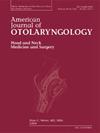Rethinking congenital cytomegalovirus: A narrative review of the clinical, public health, and ethical challenges of a preventable cause of childhood hearing loss
IF 1.7
4区 医学
Q2 OTORHINOLARYNGOLOGY
引用次数: 0
Abstract
Congenital cytomegalovirus (cCMV) is the most common non-genetic cause of pediatric sensorineural hearing loss, affecting approximately tens of thousands of infants annually in the United States. While cCMV may present symptomatically at birth, many infants are asymptomatic initially and later develop progressive or fluctuating hearing loss, which is often undiagnosed without early screening. Despite advances in diagnostic methods such as polymerase chain reaction (PCR) testing, the absence of a national screening policy in the U.S. results in significant variability in early detection and follow-up care. This narrative review provides an overview of the clinical manifestations, diagnostic strategies, and treatment options for cCMV, while highlighting critical gaps in public health infrastructure, policy coordination, and ethical oversight. Cost considerations remain a major factor in determining the feasibility of universal versus targeted screening approaches, with emerging data suggesting that both strategies offer cost-effective benefits depending on implementation context. Additionally, disparities in access to follow-up care and interventions raise important questions about health equity. Current efforts by some states to include cCMV in newborn screening protocols are promising, but without consistent national guidance, large portions of affected infants will continue to be missed. Addressing cCMV effectively will require a multidisciplinary, systems-based approach that combines early detection with sustainable follow-up, robust policy frameworks, and ethical consideration for families navigating diagnosis and care.
重新思考先天性巨细胞病毒:一种可预防的儿童听力损失病因的临床、公共卫生和伦理挑战的叙述性回顾
先天性巨细胞病毒(cCMV)是儿童感音神经性听力损失最常见的非遗传原因,在美国每年约有数万名婴儿受到影响。虽然cCMV可能在出生时出现症状,但许多婴儿最初无症状,后来发展为进行性或波动性听力损失,通常没有早期筛查就无法诊断。尽管在聚合酶链反应(PCR)检测等诊断方法方面取得了进步,但美国缺乏全国性的筛查政策,导致早期发现和后续护理方面存在显著差异。这篇叙述性综述概述了cCMV的临床表现、诊断策略和治疗方案,同时强调了公共卫生基础设施、政策协调和伦理监督方面的关键差距。成本方面的考虑仍然是决定普遍筛查方法与靶向筛查方法可行性的主要因素,新出现的数据表明,根据实施情况,这两种策略都具有成本效益。此外,在获得后续护理和干预措施方面存在的差距,引发了有关卫生公平的重要问题。目前一些州将cCMV纳入新生儿筛查方案的努力很有希望,但如果没有一致的国家指导,很大一部分受影响的婴儿将继续被遗漏。有效应对cCMV需要多学科、基于系统的方法,将早期发现与可持续的后续行动、强有力的政策框架以及对家庭进行诊断和护理的伦理考虑相结合。
本文章由计算机程序翻译,如有差异,请以英文原文为准。
求助全文
约1分钟内获得全文
求助全文
来源期刊

American Journal of Otolaryngology
医学-耳鼻喉科学
CiteScore
4.40
自引率
4.00%
发文量
378
审稿时长
41 days
期刊介绍:
Be fully informed about developments in otology, neurotology, audiology, rhinology, allergy, laryngology, speech science, bronchoesophagology, facial plastic surgery, and head and neck surgery. Featured sections include original contributions, grand rounds, current reviews, case reports and socioeconomics.
 求助内容:
求助内容: 应助结果提醒方式:
应助结果提醒方式:


